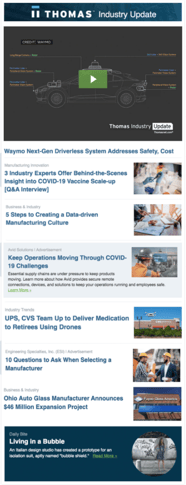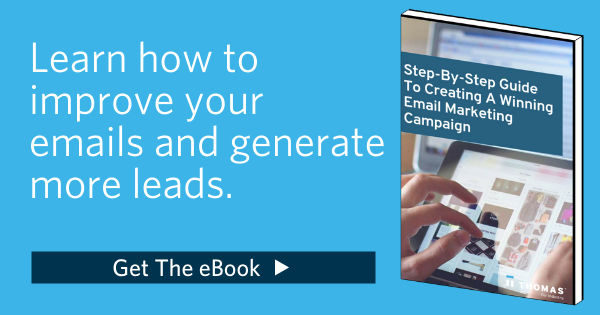Email Marketing Do’s And Don’ts For Manufacturers
Helen Carey May 5, 2021
In today’s increasingly digital landscape, email marketing is one of the best ways to remain top-of-mind with existing customers while gaining traction with potential leads. HubSpot's State Of Marketing Report states that promotional emails are still the number one type of email used by marketers. Smart email marketing tactics not only allow you to grow brand awareness, they also help spread the word about your content offerings and company news. When combined with other inbound marketing efforts, you can engage high-quality leads.
But to make the most out of your email marketing efforts and ensure you’re reaching the people you want to do business with, there are a few key do’s and don’ts to keep in mind.
 Do’s For Email Marketing
Do’s For Email Marketing
Create A Great Subject Line
First impressions really are everything. The body of your email may be fascinating, well-written, and highly informative, but it makes no difference if people aren’t opening it to begin with. Without an engaging subject line, users won’t be compelled to even open your email. In fact, an average of 33% of email recipients open emails based on the subject line.
Keep it short and sweet, and provide a clear incentive for opening your email. Crafting a concise, eye-catching subject line — one that gives users enough information to understand why opening the email will be valuable to them — is essential for drawing in readers and site visitors.
Keep your subject lines clear and succinct, appealing directly to the needs of your target audience. And, if possible, personalizing the subject line to include the recipient’s name can go a long way in capturing people’s attention, like using numbers, location, and job titles to increase your email open rates. Here are a few examples:
- 576 Of Your Design Engineering Peers Downloaded This eBook
- See The Most Requested Contract Packaging Services In 2020
- [Report] Top Sourced Industrial Products & Services In The U.S.
- What Did B2B Buyers Source This Quarter? *New Data*
Read More: 9 Tips For Writing Effective Email Subject Lines (With Examples)

Use A Branded Email Address
People like to know a real person is behind the email, so avoid using email addresses like info@yourcompanyhere or customerservice@yourcompanyhere. These look fishy, and email filters are increasingly registering them as spam. Make sure the display name of your email address is at least the real name of someone at your company.
Professionalism will win in an email campaign every time. Using a branded email address in your email marketing efforts shows prospects that you're a legitimate business that offers real products and/or services. Not to mention that branded email addresses provide more security and privacy than free email hosting platforms.
Experiment With Different Calls-To-Action (CTA)
Include a specific call to action (CTA) toward the end of your email; these serve as a way for potential customers to stay in touch with your business once they’ve finished reading your email.
For example, if you’re pushing a new eBook, you may include a CTA link encouraging users to download it. Or, if you’re announcing a new website design, you may simply direct people to your site.
Most CTAs are designed as buttons containing the given copy, but there’s a lot of opportunity for experimentation here. Play around with different text and button colors, links, and other features to test how users respond, and then assess what resonates with your audience. A/B testing can provide insight into which CTAs garner the most engagement. Helping to drive your potential customers down the marketing funnel, CTAs can play a major role in converting your subscribers to customers.
CTAs are essential for analyzing whether your email was successful. What links did the user click? Did they click on any images? Technology and marketing software from HubSpot allows for easy tracking of user interactions with your emails so that changes and improvements can then be made for future campaigns to convert those users into customers more efficiently.
See CTA Examples: 32 Industrial Lead Generation Tips, Tricks, and Ideas
Use The Right Marketing Tools
On that note, the right marketing apps and tools help you manage, measure, and report on your results. CRMs are more powerful than ever to make sure you don’t miss any opportunities and most content creation platforms are intuitive and easy to learn.
Read The List: Must-Have Digital Marketing Apps And Tools
Marketing platforms like HubSpot, Google Analytics, and Thomas WebTrax allow you to more accurately see the stages your prospects are in and see their activity so you make data-backed decisions on your online efforts.
With Thomas WebTrax, you can track the entire buying process of your industrial leads throughout your website and even your phone calls. Sign up for a free account and gain access to real-time data to create better email marketing content or request an In-Market Buyer Report to see the companies searching for your industrial products and services today.
Keep Your Message Succinct
The people reading your emails have jobs to be done. Keep your industrial marketing emails engaging and clear, and offer directly useful content to your readers.
It's important to be mindful of your prospect's time so your emails shouldn't exceed 150 words. Have more to say than can fit in that word count? Use the email to link to a blog post or some other type of marketing offer.
Learn how a Canadian electric company doubled in growth after supporting their content marketing with an email nurturing strategy.
Align Your Email Efforts With Content Marketing
Don’t cherry-pick your digital marketing tactics. You can’t think to yourself, “I need a blog, but social media’s not for me,” or “I’ll do email marketing, but I don’t have time for eBooks.” Without covering all of your content bases, you’ll have an incomplete strategy that leaves your audience unsure of what your message is. They likely won't be engaged and may unsubscribe from your email list.
Your content is what creates a connection with your prospects – and what will eventually lead to them seeking you out. When you’re creating quality content, your goal is to solve a problem for the reader, teach them something new, answer questions they may have had, or just providing them with an interesting diversion. The effect of this connection can be the difference between a conversion and a lost opportunity. Recent studies show 74% of buyers choose the rep that was first to add value and insight, so content marketing is necessary for a complete lead generation strategy. Once you realize how valuable content really is, you’ll be more confident in investing time and resources into its creation.
Learn More:
- How To Create Quality Content That Engages B2B Buyers
- eBooks vs Blogs: What's The Difference For Lead Generation?
- Content Marketing Basics: What Is It And Why Do You Need It?
Put Together A Targeted Email List
You may have great content, but if your emails aren’t reaching the right people, you won’t be garnering any new leads.
Take the time to cultivate a well-thought-out email recipient list. It should include current customers, users who have provided their contact information on your site, valuable LinkedIn and other social media connections, and industry professionals with whom you've had meaningful interactions. Cold emailing will only annoy people, and those recipients are unlikely to open your emails in the first place. So focus your efforts on those who have already expressed interest in your business and content offerings.
It’s better to send an email to a smaller group of carefully chosen people than it is to bombard a huge group of users who likely don’t have any need for the content you’re providing.
Experiment with different emails for different groups of people — emails for procurement managers, for instance, or emails directed at designers — and gauge the response.
Segment your email lists rather than emailing everyone at once. Segmenting clients and prospects based on where they are in the sales cycle and their specific personas will help hone in on users' particular needs, increasing the chances of engagement.
Try Out A/B Testing
A/B testing — in which two (or more) versions of digital marketing assets, such as emails, are created and tested against each other to gauge which performs better — can be hugely helpful for determining the most effective email marketing tactics. Try playing around with subject lines, messaging, colors, images, and CTAs to see how users respond to different options.
You can also try out A/B testing your email lists, in which one group of people receive an email formatted in a different way than another group, to determine what your audience is looking for.
Use Spell Check
Typos are a true and sure way to have prospects not take you seriously off the bat. Trust is an important element of any email campaign, especially when utilizing email to sell. Broken links, typos, and poor grammar are all elements that will have buyers crossing your business off their shortlist.

Using a marketing app like Grammarly to ensure everything you write comes across the way you intended. See more of our favorite free marketing apps and tools here.
Create A Well-Designed UX
Creating a positive user experience (UX) is just as crucial as offering valuable content. If your email formatting is confusing, outdated, or just plain boring, you run the risk of quickly losing readers’ interest. On average, recipients spend just 51 seconds reviewing an email campaign, so it’s critical to make a lasting, positive impression.
Avoid garish, overwhelming colors and fonts, and keep an eye on graphics and image sizes. You don’t want to overwhelm your audience. Make sure the body of the email isn’t too dense. If you're sending an email newsletter with more than one link to a blog or eBook, use photos to break up different sections of writing. Consider using bullets to separate paragraphs.
Including the right type of images is also critical for capturing users’ attention; don’t just include graphics or photos for the sake of it. Users can spot sloppy or lazy formatting, and an unprofessional or outdated image will only detract from your content. Use images that speak to your brand and relate to the content you’re offering, and make sure the image sizes aren't too large or the emails may never even make it into users’ inboxes.
To get some ideas for sophisticated, clean email design, check out some of these examples. Our Thomas Industry Update email newsletter seen here incorporates videos, graphics, headlines, and sponsored content into its design. To keep the reader engaged and encourage clicks, a video preview image is used with clear, compelling headlines. More than 300,000 subscribers read Thomas Industry Update to lead their businesses, find new industry partners, and advance their industrial careers.
“We knew we wanted to make more buyers and decision-makers aware of what we have to offer," said Mark T., Toagosei America, an industrial adhesives manufacturer. "Thomas Industry Update ended up being a great way to help us generate that awareness and we earned new contacts for our sales team to call on. We earned more than 73k impressions in one TIU email send and would recommend their advertising to other manufacturers and industrial companies who are interested in growing their business.”
Promote Your Company: Learn how you can promote your business in the email too
Don’ts For Email Marketing
Over Promotional Email Campaigns
Users read your emails hoping to gain insight into industry challenges, learn more about your offerings, and keep up with relevant news. So don’t make sales pitches out of all your emails, and always write with the reader in mind.
Similarly, avoid using words that will set off spam filters. Emails with overly promotional language that rely heavily on words like “free,” “sale,” “cash,” and so on are likely to end up in users’ spam folders, meaning your target audience won’t even get the chance to read your message in the first place. Campaign metadata, IP addresses, coding, content and format can all cause an email send to fail. Learn how to overcome these types of spam filters here.
Although it's important to let readers know what your company is all about and what you're offering, your emails should directly show how you can help fix their pain points and address their concerns. This is another reason why creating lists and knowing your audience is necessary.
For example, if someone viewed a blog post on your website once, it may not be a great idea to try and immediately sell them something. They are likely still in the research phase. (More on the industrial buying process and stages here.) Know which part of the funnel your readers are at and hit them with messaging that is in line with a specific part of the buying process. Top-of-the-funnel users usually need more email nurturing than someone with whom you already have a relationship.
Learn More: How To Meet The Needs Of Your B2B Buyers

Forgetting To Optimize Emails Across All Email Platforms (And Devices!)
Don’t forget to double-check how your emails look on different email clients. Try out different options, such as Gmail, Apple Mail, or Outlook to see how your messages appear across different clients. Formatting should remain consistent. Remember that over half of your contacts will likely check emails from a mobile device, so ensure your messages are optimized for all types of devices.
No Option To Unsubscribe
Don’t prevent people from unsubscribing. Failing to include a way for people to opt-out of your emails isn’t just unethical — it’s also unlawful under various consumer-protection regulations, such as the CAN-SPAM Act.
Purchasing A List Of Email Prospects
Although purchasing email lists might seem like a quick and easy win, it's most often a mistake. Why? There's no guarantee that the names on your list will actually want to receive information about your company, products or services. More often than not, quality leads are better than quantity.
Leads from a purchased list are less likely to engage with you since they have no prior connection to your business, and god forbid they mark your email as spam. One of the last places you want to end up is in someone's junk folder, because this can lower the reputation of your company and decreases your chances of connecting with qualified buyers.
Any users you connect with in this way won’t have opted to receive communications from you, and they won’t appreciate you cluttering their inbox. No good business relationship has ever started with “How did you get my information?”
Dive Deeper: How Sales & Marketing Pros Can Build Effective Prospect Email Lists
Learn More Email Marketing Best Practices
Industrial marketing emails are a powerful tool and can help gain new clients and garner more brand awareness. But sending off emails without a solid game plan and incorporating other online efforts won’t yield high-quality results. So be sure to take the time to create a multifaceted marketing strategy that will reach the right people with the right information.
Need help getting started or looking for ways to boost your existing email marketing efforts? Thomas offers a free digital health check to see exactly how you improve and what you can do to stay ahead of competitors. Or learn how to improve your campaigns with our step-by-step guide, "Creating Lead Generating Email Campaigns For Beginners."
"A key thing about Thomas is the ability to generate a lot of leads across various industries," said Renown Electric. "We wanted to help educate our customers. Through eBooks, blogs, a revamped website — they actually drive our own knowledge out and customers appreciate the insight."
Check out the additional resources below for more best practices:
- 9 Email Marketing Types To Help You Engage More Buyers
- Step-By-Step Guide To Creating A Winning Email Marketing Campaign
- Creating More Content After Your First Marketing Campaign
- Manufacturer's Step By Step Guide To Turning Anonymous Traffic To Leads
- Beginner's Guide To Content Marketing For Industrial Companies
Did you find this useful?









